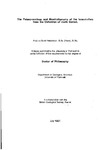The Palaeo-ecology and Biostratigraphy of the foraminifera from the Oxfordian of north Dorset
| dc.contributor.author | Henderson, Andrew Scott | |
| dc.contributor.other | School of Geography, Earth and Environmental Sciences | en_US |
| dc.date.accessioned | 2013-10-03T12:06:23Z | |
| dc.date.available | 2013-10-03T12:06:23Z | |
| dc.date.issued | 1997 | |
| dc.identifier | NOT AVAILABLE | en_US |
| dc.identifier.uri | http://hdl.handle.net/10026.1/2002 | |
| dc.description.abstract |
The Oxfordian rocks of north Dorset are poorly exposed at outcrop. A drilling operation was devised and implemented and the complete sequence of strata from the Weymouth Member of the Oxford Clay Formation through to the Ringstead Waxy Clay Formation was penetrated. Three boreholes were drilled; the Hallett's Farm Borehole, covering the strata from the stratigraphically youngest Ringstead Waxy Clay Formation down to the Cucklington Oolite; the Bowden Farm Borehole, continuing the sequence from the Cucklington Oolite into the lower part of the Hazelbury Bryan Formation and the Hartmoor Hill Borehole which continues downward into the Oxford Clay Formation. A continuous succession of the Corallian rocks from north Dorset was obtained. The fresh borehole material was examined for microfossils, with further samples coming from the BGS East Stour Borehole. A diverse assemblage was extracted. The foraminiferal assemblage was examined and includes representatives of 26 families, comprising 26 genera and 148 species. All species were identified and the taxonomy of each studied and described or confirmed. The assemblage is more diverse than previously recorded Corallian assemblages, partly due to the freshness of the borehole material which is not affected by the weathering processes present at surface outcrops. The regional lithostratigraphy defined by the British Geological Survey (Bristow et al, 1995) is confirmed and lithological boundaries not visible at outcrop are described. The distribution and abundance patterns of foraminiferal taxa are analysed and various statistical indices are compared for each borehole. Multivariate methods are employed and in particular non-metric Multidimensional Scaling is used in an attempt to divide the samples into groups which are palaeo-environmentally significant. The authenticity of this method is checked against a Hierarchical Agglomerative Clustering technique. The sample groups are used to define biofacies, fifteen of which are recognised within the studied interval. The correlation of the four boreholes is achieved using lithological techniques, ammonite zonation, foraminiferal biohorizons and the biofacies defined by multivariate analysis. A total of 21 biohorizons are identified with certain horizons coinciding with lithological boundaries and previously defined unconformities recognised within the Oxfordian of Dorset. The long ranging nature of the majority of Upper Jurassic foraminifera precludes the definition of a rigorous biostratigraphic zonation. The important biostratigraphic species for the Upper Jurassic are recorded however, and a tentative zonation, based on the concept of interval zones (Salvador, 1995) is proposed. Eleven zones are recognised. | en_US |
| dc.description.sponsorship | British Geological Survey, Exeter | en_US |
| dc.language.iso | en | en_US |
| dc.publisher | University of Plymouth | en_US |
| dc.title | The Palaeo-ecology and Biostratigraphy of the foraminifera from the Oxfordian of north Dorset | en_US |
| dc.type | Thesis | |
| plymouth.version | Full version | en_US |
| dc.identifier.doi | http://dx.doi.org/10.24382/4227 | |
| dc.identifier.doi | http://dx.doi.org/10.24382/4227 |
Files in this item
This item appears in the following Collection(s)
-
01 Research Theses Main Collection
Research Theses Main


